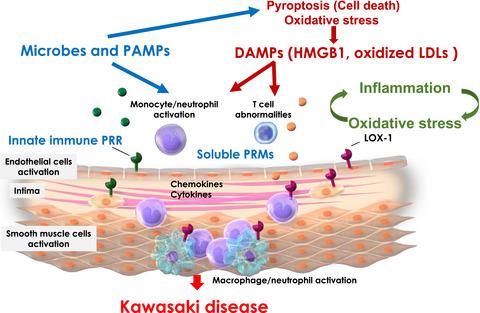当前位置:
X-MOL 学术
›
Clin. Transl. Immunol.
›
论文详情
Our official English website, www.x-mol.net, welcomes your
feedback! (Note: you will need to create a separate account there.)
The up‐to‐date pathophysiology of Kawasaki disease
Clinical & Translational Immunology ( IF 4.6 ) Pub Date : 2021-05-10 , DOI: 10.1002/cti2.1284 Toshiro Hara 1 , Kenichiro Yamamura 2 , Yasunari Sakai 3
Clinical & Translational Immunology ( IF 4.6 ) Pub Date : 2021-05-10 , DOI: 10.1002/cti2.1284 Toshiro Hara 1 , Kenichiro Yamamura 2 , Yasunari Sakai 3
Affiliation

|
Kawasaki disease (KD) is an acute systemic vasculitis of an unknown aetiology. A small proportion of children exposed to severe acute respiratory syndrome coronavirus 2 (SARS‐CoV‐2) or infected by Yersinia reproducibly develop principal symptoms of KD in various ethnic areas, but not in all studies. These microbes provoke a rapid cell‐damaging process, called ‘pyroptosis’, which is characterised by a subsequent release of proinflammatory cellular components from damaged endothelial and innate immune cells. In agreement with these molecular events, patients with KD show elevated levels of damage‐associated molecular patterns derived from cell death. In addition, an overwhelming amount of oxidative stress‐associated molecules, including oxidised phospholipids or low‐density lipoproteins, are generated as by‐products of inflammation during the acute phase of the disease. These molecules induce abnormalities in the acquired immune system and activate innate immune and vascular cells to produce a range of proinflammatory molecules such as cytokines, chemokines, proteases and reactive oxygen species. These responses further recruit immune cells to the arterial wall, wherein inflammation and oxidative stress closely interact and mutually amplify each other. The inflammasome, a key component of the innate immune system, plays an essential role in the development of vasculitis in KD. Thus, innate immune memory, or ‘trained immunity’, may promote vasculitis in KD. Hence, this review will be helpful in understanding the pathophysiologic pathways leading to the development of principal KD symptoms and coronary artery lesions in patients with KD, as well as in subsets of patients with SARS‐CoV‐2 and Yersinia infections.
中文翻译:

川崎病的最新病理生理
川崎病(KD)是一种病因不明的急性系统性血管炎。一小部分暴露于严重急性呼吸系统综合症冠状病毒2(SARS-CoV-2)或被耶尔森氏菌感染的儿童在各个种族地区可再现地发展KD的主要症状,但并非在所有研究中都如此。这些微生物引起了快速的细胞破坏过程,称为“ pyroptosis”,其特征是随后从受损的内皮细胞和先天免疫细胞释放促炎细胞成分。与这些分子事件相一致,KD患者显示出源自细胞死亡的与损伤相关的分子模式水平升高。此外,在疾病的急性期,炎症的副产物还产生了大量的与氧化应激相关的分子,包括氧化的磷脂或低密度脂蛋白。这些分子会诱导获得性免疫系统异常,并激活先天免疫和血管细胞,从而产生一系列促炎分子,例如细胞因子,趋化因子,蛋白酶和活性氧。这些反应进一步将免疫细胞募集到动脉壁,其中炎症和氧化应激彼此紧密相互作用并相互放大。炎性小体是先天免疫系统的关键组成部分,在KD的血管炎的发展中起着至关重要的作用。因此,先天性免疫记忆或“训练性免疫”可能会促进KD中的血管炎。因此,本综述将有助于了解导致KD患者以及SARS-CoV-2和SARS患者亚群中主要KD症状和冠状动脉病变发展的病理生理途径。其中炎症和氧化应激紧密相互作用并相互放大。炎性小体是先天免疫系统的关键组成部分,在KD的血管炎的发展中起着至关重要的作用。因此,先天性免疫记忆或“训练性免疫”可能会促进KD中的血管炎。因此,本综述将有助于了解导致KD患者以及SARS-CoV-2和SARS患者亚群中主要KD症状和冠状动脉病变发展的病理生理途径。其中炎症和氧化应激紧密相互作用并相互放大。炎性小体是先天免疫系统的关键组成部分,在KD的血管炎的发展中起着至关重要的作用。因此,先天性免疫记忆或“训练性免疫”可能会促进KD中的血管炎。因此,本综述将有助于了解导致KD患者以及SARS-CoV-2和SARS患者亚群中主要KD症状和冠状动脉病变发展的病理生理途径。耶尔森氏菌感染。
更新日期:2021-05-11
中文翻译:

川崎病的最新病理生理
川崎病(KD)是一种病因不明的急性系统性血管炎。一小部分暴露于严重急性呼吸系统综合症冠状病毒2(SARS-CoV-2)或被耶尔森氏菌感染的儿童在各个种族地区可再现地发展KD的主要症状,但并非在所有研究中都如此。这些微生物引起了快速的细胞破坏过程,称为“ pyroptosis”,其特征是随后从受损的内皮细胞和先天免疫细胞释放促炎细胞成分。与这些分子事件相一致,KD患者显示出源自细胞死亡的与损伤相关的分子模式水平升高。此外,在疾病的急性期,炎症的副产物还产生了大量的与氧化应激相关的分子,包括氧化的磷脂或低密度脂蛋白。这些分子会诱导获得性免疫系统异常,并激活先天免疫和血管细胞,从而产生一系列促炎分子,例如细胞因子,趋化因子,蛋白酶和活性氧。这些反应进一步将免疫细胞募集到动脉壁,其中炎症和氧化应激彼此紧密相互作用并相互放大。炎性小体是先天免疫系统的关键组成部分,在KD的血管炎的发展中起着至关重要的作用。因此,先天性免疫记忆或“训练性免疫”可能会促进KD中的血管炎。因此,本综述将有助于了解导致KD患者以及SARS-CoV-2和SARS患者亚群中主要KD症状和冠状动脉病变发展的病理生理途径。其中炎症和氧化应激紧密相互作用并相互放大。炎性小体是先天免疫系统的关键组成部分,在KD的血管炎的发展中起着至关重要的作用。因此,先天性免疫记忆或“训练性免疫”可能会促进KD中的血管炎。因此,本综述将有助于了解导致KD患者以及SARS-CoV-2和SARS患者亚群中主要KD症状和冠状动脉病变发展的病理生理途径。其中炎症和氧化应激紧密相互作用并相互放大。炎性小体是先天免疫系统的关键组成部分,在KD的血管炎的发展中起着至关重要的作用。因此,先天性免疫记忆或“训练性免疫”可能会促进KD中的血管炎。因此,本综述将有助于了解导致KD患者以及SARS-CoV-2和SARS患者亚群中主要KD症状和冠状动脉病变发展的病理生理途径。耶尔森氏菌感染。











































 京公网安备 11010802027423号
京公网安备 11010802027423号